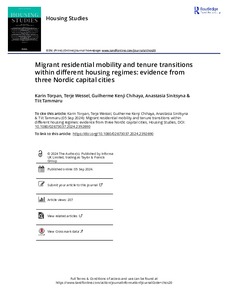Migrant residential mobility and tenure transitions within different housing regimes: evidence from three Nordic capital cities
Torpan, Karin; Wessel, Terje; Chihaya, Guilherme Kenji; Sinitsyna, Anastasia; Tammaru, Tiit
Migrant residential mobility and tenure transitions within different housing regimes: evidence from three Nordic capital cities
Torpan, Karin
Wessel, Terje
Chihaya, Guilherme Kenji
Sinitsyna, Anastasia
Tammaru, Tiit
Routledge
Julkaisun pysyvä osoite on:
https://urn.fi/URN:NBN:fi-fe2025082787815
https://urn.fi/URN:NBN:fi-fe2025082787815
Tiivistelmä
Migrant housing-related disadvantages and residential segregation are both important concerns in migrant-receiving countries. However, there exists little understanding about the connection between the two. According to the spatial assimilation framework, migrants who establish themselves in the labour market and experience income increase tend to move to higher-income neighbourhoods. However, migrant opportunities to rent or buy an apartment may vary across cities due to each city having its own distinctive housing regimes, along with related tenure structures, as emphasised by the housing availability framework. Different opportunity structures may lead to different pathways of spatial assimilation, as moving into a higher-income neighbourhood does not necessarily entail becoming a homeowner, and vice versa. The main findings of our comparative and longitudinal study reveal that different pathways of spatial assimilation indeed do arise in cities which have different housing regimes, as has been proposed by the housing availability framework.
Kokoelmat
- Rinnakkaistallenteet [27094]
